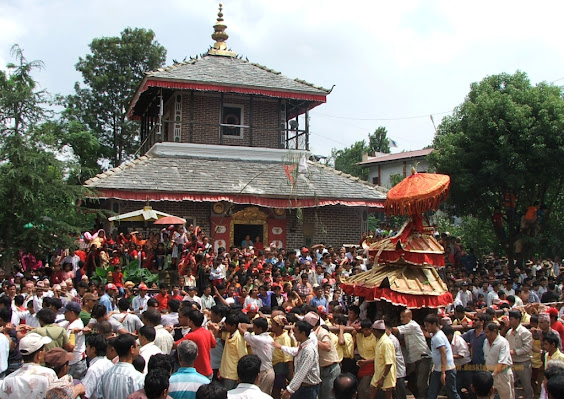Colonel Ujirsingh Thapa Magar initiated the chariot festival of Ranojjeshwori Jatra in Tansen of Palpa district to commemorate the victory of the Nepalese army over the British army in the Anglo-Nepalese war in 1815 AD. This festival has been held on the next day of Krishna Janmashtami continuously since 1862 AD (1877 BS). Colonel Thapa, before going to the battlefield, offered worship to the goddess Bhagwati, and promised to build a grand temple in her name if he won, and he would take out a chariot procession every year with state honors. Besides the blessings of the goddess, the other factor behind the defeat of the 4000 British troops led by Major General John Sullivan Wood was undoubtedly the skillful leadership of the 21-year-old Nepali commander Colonel Thapa. Despite of the relatively small number of soldiers, the Nepalese army won the battle.
Battle of Jitgadhi
The Anglo-Nepalese War of 1814–1816 was a major military conflict between the British East India Company and Nepal. This war took place mainly in the mountainous regions of present-day Nepal. The Battle of Jitgadhi in Butwal was a notable battle during this war.
The Battle of Jitgadhi took place a strategic fort located in Butwal of present-day Nepal. The British East India Company sought to expand its territory and influence in South Asia. Nepal was expanding its dominion over the Terai plains and other territories historically disputed between Nepal and British India. The British launched an offensive against the Nepali forces in the area with the aim of capturing strategic positions and establishing control. The Battle of Jitgadhi was an important engagement during this invasion. In the Battle of Jitgadhi, the army led by Col Thapa defeated the British in Jitgadhi on 7th Baisakh 1872 BS. Before going to war, he had promised Goddess Bhagwati to build a big temple and if he won, he would start a chariot festival in her honor.
According to Nirmal Shrestha, a Palpa based author, Colonel Thapa Magar started construction of the Bhagwati temple in 1815 AD (1872 BS) and completed the construction of the three-story temple in 1819 AD (1876 BS).
The temple has an inner circular walkway flanked by the God Sun, Lord Vishnu, a Shiva Linga and Lord Ganesha at the four corners. The original idol of the goddess is kept away from public viewing in the inner sanctum. Instead, the 19th century 36-inch-tall idol made of eight different metals (Ashtadhatu) is worshipped. The statue has a statue of Goddess Bhagwati with 18 hands seated on a lion.
The Hindu temple of Bhagwati priests are Buddhists of the Vajrayani sect, who oversee the daily rituals of the Hindu goddess. This is a unique example of religious harmony in the country. The temple was damaged in the earthquake of 1934 but was spared from the 'Gorkha' earthquake of 2015. It has gone through several stages of reconstruction in 1829 AD, 1880 AD, 1942 AD and 1974 AD. Colonel Thapa had set aside about 500 acres of land and set up a Guthi (Trust) for maintenance of the temple and conduct the annual chariot festival. According to Chhatraraj Shakya, a senior intellectual from Palpa, there are many Jatras celebrated in Nepal to celebrate the defeat of the demons that afflict mankind, but the Ranojjeshwori Bhagwati Jatra of Palpa may be the only Jatra celebrated to celebrate the victory of the British army in war.
Ranojjeshwori Bhagwati Jatra, which has been celebrated continuously since the year 1820 AD except for the postponement of the Jatra once in 2020 AD due to the risk of Corona, is certainly a Jatra of national pride. According to writer Nirmal Shrestha, now is the time to capitalize on the glorious history of Palpa Bhagwati Jatra, which has been going on since tradition.
Tansen: a contender for World Heritage recognition
Tansen is a testament to the living heritage and architecture of the Newa and Magar civilizations. Various ruins from the Sen period (15th to 18th centuries) can be found. The medieval settlement houses many temples, monasteries, and monuments like Bhairab Temple, Purankot Palace, Srinagar Palace, Vansh Gopal, Mukundeswara Mahadev, Amar Narayan Temple, Ran-Ujjeshwari Bhagwati Temple, and Tansen Durbar. The medieval town of Tansen can be compared to the architectural excellence of settlements within the Kathmandu Valley, but has a different significance due to its unique history and location. Based on these special qualities, the Department of Archeology of the Government of Nepal has applied to UNESCO to include the medieval settlement of Tansen in the list of world heritage sites according to UNESCO standards No. 3, 4 and 6 on January 30, 2008. It is not too late for the archeology department, Tansen municipality, local organizations, and intellectuals to take initiative to fulfill this purpose.




